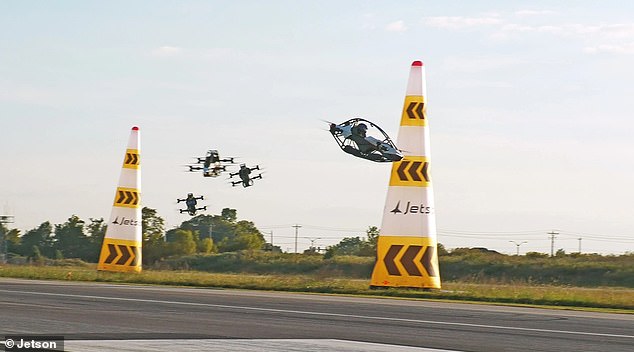What once seemed like a sci-fi dream is now roaring through the skies.
The world has just witnessed its first-ever flying car race — and it’s as thrilling as it sounds.
The event, dubbed the Jetson Air Games, is being hailed as the “Formula One of the skies,” featuring personal electric aircraft zooming through an aerial track like something out of Star Wars.
A New Kind of Race
The competition saw four Jetson One vehicles go head-to-head in a twisting, high-speed course suspended in the air.
Each pilot maneuvered their sleek, single-seater aircraft around sharp turns and narrow passes, hitting speeds of up to 63 miles per hour (102 km/h).
The race wasn’t just about adrenaline — it served as a proof of concept to show that competitive air racing could become the next big thing in motorsports.
The event took place at the UP.Summit in Texas, where Jetson also pulled off another first: a synchronized four-person formation flight.
The crowd erupted with excitement as the futuristic machines darted through the air, leaving spectators in awe.
Fans Can’t Get Enough
Social media users quickly turned the Jetson Air Games into a viral sensation.
Comments flooded YouTube and X (formerly Twitter), with one fan writing, “Hell yes! This is what we were promised back in the 80s. We need more of this!”
Others expressed disbelief that something straight out of a childhood fantasy had become real.
Another commenter gushed, “Never thought I’d live to see this — what a time to be alive!”
For many, this was more than a race — it was the beginning of a new era in personal transportation.
Safety Fears Loom Over the Excitement
Despite the buzz, some tech enthusiasts were quick to voice concerns.
The Jetson One’s open cockpit design and 5000rpm propellers raised questions about safety.
One user joked, “The phrase ‘Everyone is a pilot’ should scare every real pilot out there.”
Another warned, “When this becomes a competitive sport, it’ll be more dangerous than F1!”
Jetson, however, insists safety is a top priority.
The aircraft can still fly with one propeller out and features an automatic emergency landing system.
There’s also a ballistic parachute that deploys if things go wrong mid-air — offering an extra layer of reassurance to pilots.
Inside the Jetson One
The Jetson One is a lightweight electric eVTOL (electric vertical takeoff and landing) vehicle, designed for a single passenger.
Weighing around 190 pounds (86 kg), it combines a carbon fiber and aluminum frame with eight high-powered rotors.
Its flight range reaches 20 miles (32 km), and it can soar up to 1,500 feet (457 meters) above the ground for about 20 minutes per trip.
Operating the Jetson One doesn’t require a pilot’s license in the U.S. — a fact that has helped fuel its growing popularity.
Its control setup is simple: a three-axis joystick and throttle lever, making it intuitive even for beginners.
A Pricey Ticket to the Skies
Flying one of these futuristic machines doesn’t come cheap.
The Jetson One currently costs $128,000 (£95,380), with prices expected to rise to $148,000 (£110,290) soon.
Yet that hasn’t slowed demand — the company sold out its first batch immediately after its 2021 launch and now has around 550 pending orders valued at $75 million (£55.9 million).
Among its first owners is Palmer Luckey, the defense-tech entrepreneur behind Oculus VR, who reportedly completed Jetson’s ground training in under an hour before taking off on his own.
From Rescue Missions to Real-World Testing
Beyond racing, Jetson has been testing its aircraft in real-life situations.
In collaboration with the Polish Mountain Rescue Service, the Jetson One was put through its paces in the rugged Tatra Mountains.
Despite wind speeds of up to 36 miles per hour, the aircraft handled the conditions impressively — a promising sign for potential rescue and emergency applications.
The Road (or Sky) Ahead
For now, flying restrictions prevent Jetson Ones from being used in urban areas, but the company’s founders believe that will change as society embraces air mobility.
Co-founder Peter Ternström envisions a world where cities become greener and less congested because transportation moves vertically, not horizontally.
“For our children, cities can be cleaner and quieter — no need for endless parking lots or roads when travel goes up instead of forward,” Ternström said.
“People think it’s crazy, but evolution happens quickly. Our goal is to make everyone a pilot within a decade.”
What Comes Next?
Jetson hasn’t yet revealed when or where the next Air Games event will take place, but anticipation is already sky-high.
Fans are clamoring for more races, and if the first one is any indication, the future of competitive flying is ready to take off — literally.
The dream of personal flight, once limited to movies and imagination, is finally within reach.
And as Jetson continues to refine its technology, one thing is clear — the race for the skies has just begun.
Share on Facebook «||» Share on Twitter «||» Share on Reddit «||» Share on LinkedIn